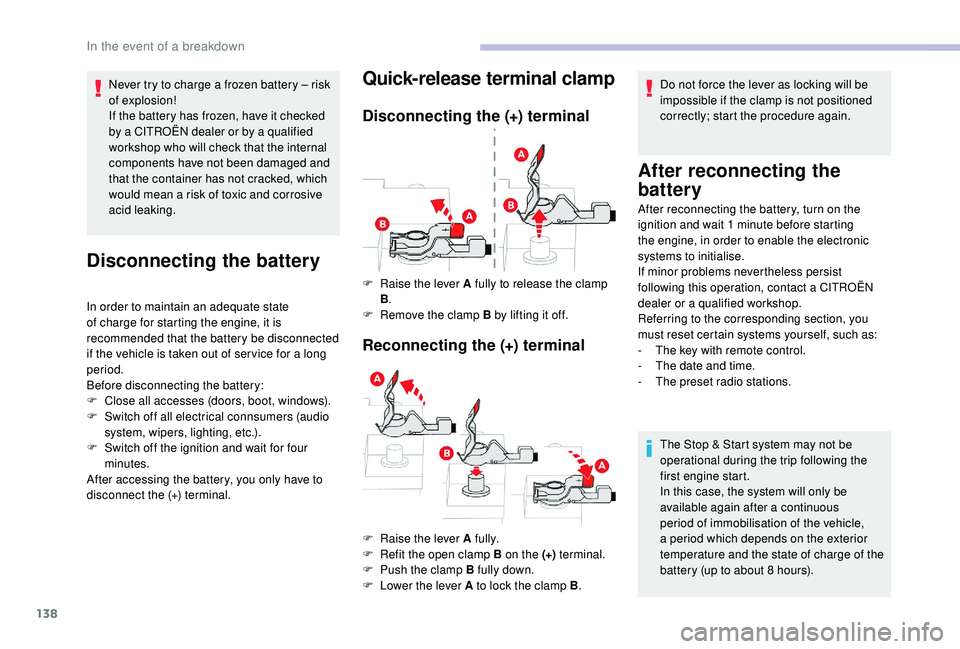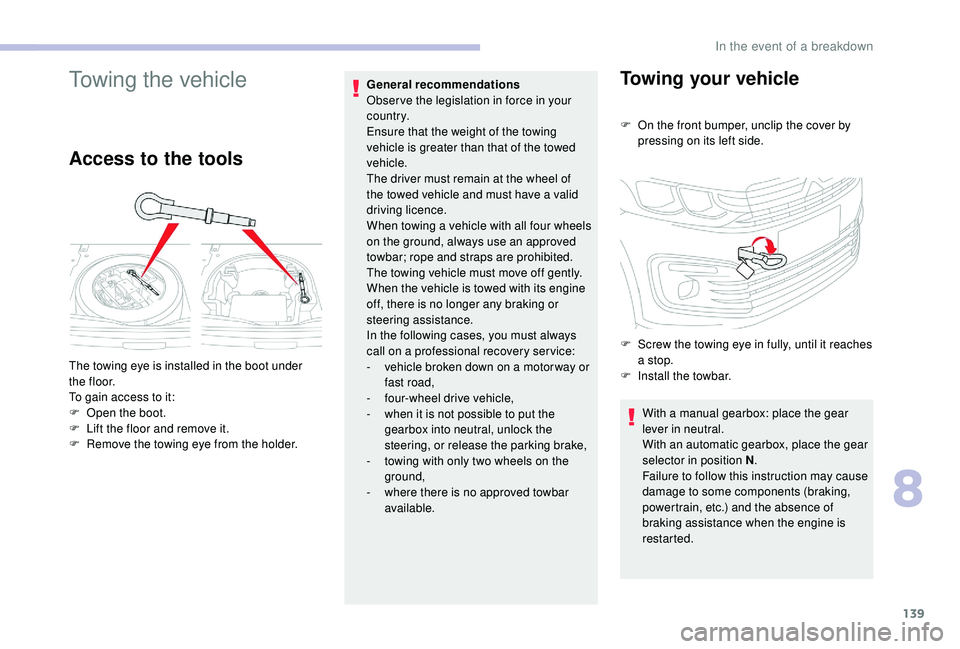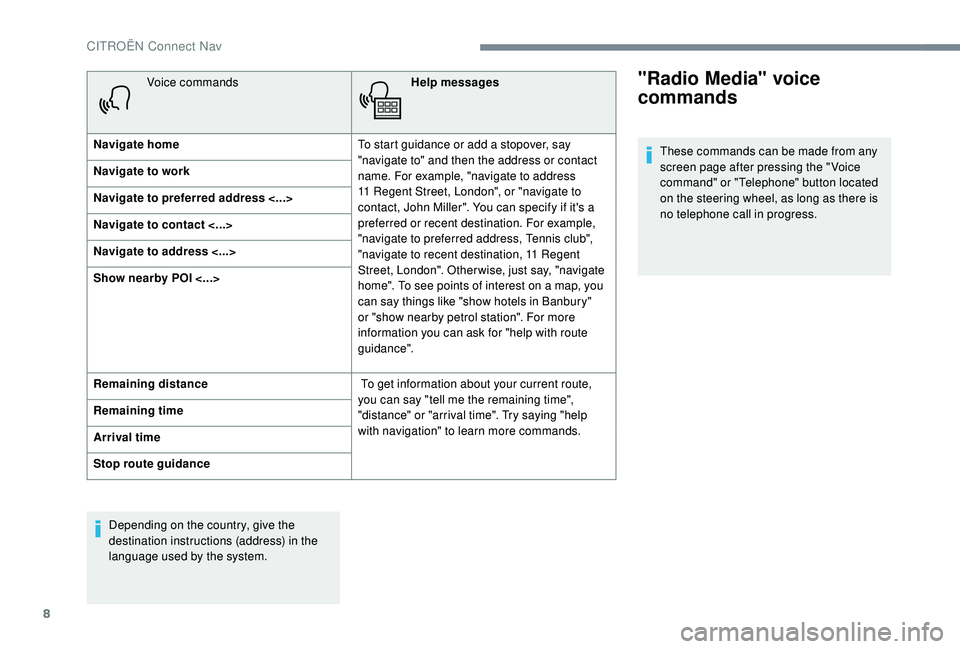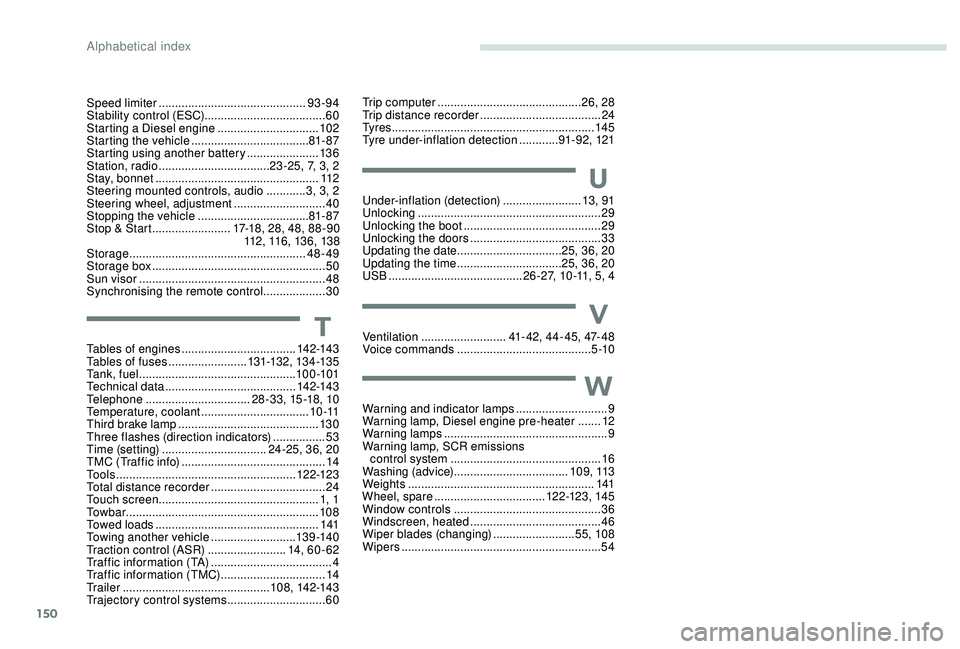stop start CITROEN C-ELYSÉE 2018 Handbook (in English)
[x] Cancel search | Manufacturer: CITROEN, Model Year: 2018, Model line: C-ELYSÉE, Model: CITROEN C-ELYSÉE 2018Pages: 260, PDF Size: 8.4 MB
Page 139 of 260

137
F Wait for it to return to idle.
F D isconnect the jump lead cables in reverse
o r d e r.
F
R
efit the plastic cover to the (+) terminal, if
your vehicle has one.
F
A
llow the engine to run for at least
30
minutes, by driving or with the vehicle
stationary, so that the battery reaches an
adequate state of charge.
Some functions, including Stop & Start,
are not available if the battery is not
sufficiently charged.
Charging the battery using
a battery charger
For optimum ser vice life of the battery, it is
essential to maintain an adequate state of
charge.
In some circumstances it may be necessary to
charge the battery:
-
I
f you use your vehicle essentially for short
journeys.
-
I
f the vehicle is to be taken off the road for
several weeks.
Contact a CITROËN dealer or a qualified
workshop. If you plan to charge your vehicle's battery
yourself, use only a charger compatible
with lead-acid batteries of a nominal
voltage of 12
V.
Follow the instructions provided by the
manufacturer of the charger.
Never reverse polarities.
It is not necessary to disconnect the
battery.
F
S
witch off the ignition.
F
S
witch off all electrical consumers (audio
system, lighting, wipers, etc.). F
S
witch off the charger B before connecting
the cables to the battery, so as to avoid any
dangerous sparks.
F
E
nsure that the charger cables are in good
condition.
F
R
aise the plastic cover, if your vehicle has
one, on the (+) terminal.
F
C
onnect the charger B cables as follows:
-
T
he positive (+) red cable to the (+)
terminal of the battery A .
-
T
he negative (-) black cable to the earth
point C on the vehicle.
F
A
t the end of the charging operation, switch
off charger B before disconnecting the
cables from battery A .
If this label is present, it is essential to
use only a 12 V charger to avoid causing
irreversible damage to the electrical
components related to the Stop & Start
system.
8
In the event of a breakdown
Page 140 of 260

138
Never try to charge a frozen battery – risk
of explosion!
If the battery has frozen, have it checked
by a CITROËN dealer or by a qualified
workshop who will check that the internal
components have not been damaged and
that the container has not cracked, which
would mean a risk of toxic and corrosive
acid leaking.
Disconnecting the battery
In order to maintain an adequate state
of charge for starting the engine, it is
recommended that the battery be disconnected
if the vehicle is taken out of ser vice for a long
period.
Before disconnecting the battery:
F
C
lose all accesses (doors, boot, windows).
F
S
witch off all electrical connsumers (audio
system, wipers, lighting, etc.).
F
S
witch off the ignition and wait for four
minutes.
After accessing the battery, you only have to
disconnect the (+) terminal.
Quick-release terminal clamp
Disconnecting the (+) terminal
Reconnecting the (+) terminal
Do not force the lever as locking will be
impossible if the clamp is not positioned
correctly; start the procedure again.
After reconnecting the
battery
F Raise the lever A fully to release the clamp B.
F
R
emove the clamp B by lifting it off.
F
Ra
ise the lever A fully.
F
R
efit the open clamp B on the (+) terminal.
F
P
ush the clamp B fully down.
F
L
ower the lever A to lock the clamp B .After reconnecting the battery, turn on the
ignition and wait 1
minute before starting
the engine, in order to enable the electronic
systems to initialise.
If minor problems nevertheless persist
following this operation, contact a CITROËN
dealer or a qualified workshop.
Referring to the corresponding section, you
must reset certain systems yourself, such as:
-
T
he key with remote control.
-
T
he date and time.
-
T
he preset radio stations.
The Stop & Start system may not be
operational during the trip following the
first engine start.
In this case, the system will only be
available again after a continuous
period of immobilisation of the vehicle,
a period which depends on the exterior
temperature and the state of charge of the
battery (up to about 8
hours).
In the event of a breakdown
Page 141 of 260

139
Towing the vehicle
Access to the tools
General recommendations
Obser ve the legislation in force in your
c o u nt r y.
Ensure that the weight of the towing
vehicle is greater than that of the towed
vehicle.
The driver must remain at the wheel of
the towed vehicle and must have a valid
driving licence.
When towing a vehicle with all four wheels
on the ground, always use an approved
towbar; rope and straps are prohibited.
The towing vehicle must move off gently.
When the vehicle is towed with its engine
off, there is no longer any braking or
steering assistance.
In the following cases, you must always
call on a professional recovery ser vice:
-
v
ehicle broken down on a motor way or
fast road,
-
f
our-wheel drive vehicle,
-
w
hen it is not possible to put the
gearbox into neutral, unlock the
steering, or release the parking brake,
-
t
owing with only two wheels on the
ground,
-
w
here there is no approved towbar
available.Towing your vehicle
F On the front bumper, unclip the cover by pressing on its left side.
The towing eye is installed in the boot under
t h e f l o o r.
To gain access to it:
F
O
pen the boot.
F
L
ift the floor and remove it.
F
R
emove the towing eye from the holder. F
S
crew the towing eye in fully, until it reaches
a stop.
F
I
nstall the towbar.With a manual gearbox: place the gear
lever in neutral.
With an automatic gearbox, place the gear
selector in position N .
Failure to follow this instruction may cause
damage to some components (braking,
powertrain, etc.) and the absence of
braking assistance when the engine is
restarted.
8
In the event of a breakdown
Page 156 of 260

8
Voice commandsHelp messages
Navigate home To start guidance or add a stopover, say
"navigate to" and then the address or contact
name. For example, "navigate to address
11
Regent Street, London", or "navigate to
contact, John Miller". You can specify if it's a
preferred or recent destination. For example,
"navigate to preferred address, Tennis club",
"navigate to recent destination, 11
Regent
Street, London". Other wise, just say, "navigate
home". To see points of interest on a map, you
can say things like "show hotels in Banbury"
or "show nearby petrol station". For more
information you can ask for "help with route
guidance".
Navigate to work
Navigate to preferred address <...>
Navigate to contact <...>
Navigate to address <...>
Show nearby POI <...>
Remaining distance
To get information about your current route,
you can say "tell me the remaining time",
"distance" or "arrival time". Try saying "help
with navigation" to learn more commands.
Remaining time
Arrival time
Stop route guidance
Depending on the country, give the
destination instructions (address) in the
language used by the system."Radio Media" voice
commands
These commands can be made from any
screen page after pressing the " Voice
command" or "Telephone" button located
on the steering wheel, as long as there is
no telephone call in progress.
CITROËN Connect Nav
Page 241 of 260

19
The Apple® player is not recognised when
connecting to the USB port. The Apple® player is of a generation that is not
compatible with a USB connection. Connect the Apple® player to the AUX Jack
socket using a suitable cable (not supplied).
The hard disk or peripheral is not recognised
when connecting to the USB port. Some hard disks and devices need a power
supply greater than is provided by the audio
system.Connect the peripheral to the 230
V socket, the
12V socket or an external power supply.
Caution : ensure that the device does not
transmit a voltage greater than 5
V (risk of
destruction of the system).
When streaming, the sound cuts out
m o m e nt a r i l y. Some telephones prioritise connection of the
"hands-free" profile.Delete the "hands-free" connection profile to
improve streaming.
In "Random all" play, not all of the tracks are
played. In "Random all" play, the system can only take
into account up to 999
tracks.
With the engine off, the audio system switches
off after a few minutes of use. When the engine is switched off, the audio
system operating time depends on the battery
charge.
The switch-off is normal: the audio system
switches to economy mode and switches off to
prevent discharging the vehicle's battery.Start the vehicle’s engine to increase the
battery charge.
The message "the audio system is overheated"
appears on the display. In order to protect the installation if the
surrounding temperature is too high, the audio
system switches to an automatic thermal
protection mode leading to a reduction of the
volume or stopping of the playing of the CD.Switch the audio system off for a few minutes
to allow the system to cool.
.
Bluetooth® audio system
Page 256 of 260

150
Speed limiter .............................................93 -94
Stability control (ESC)..................................... 60
Starting a Diesel engine
............................... 10
2
Starting the vehicle
.................................... 81
- 87
Starting using another battery
......................13 6
Station, radio
...............................
...23 -25, 7, 3, 2
Stay, bonnet
.................................................. 112
Steering mounted controls, audio
............ 3
, 3, 2
Steering wheel, adjustment
............................ 40
S
topping the vehicle
..................................81- 87
Stop & Start
........................ 17-18, 28, 48, 88 -90
112, 116, 136, 138
Storage
...................................................... 48-49
Storage box
..................................................... 50
Sun visor
...............................
..........................48
Synchronising the remote control
...................30
Tables of engines
................................... 142-143
Tables of fuses
........................131-132, 13 4 -13 5
Ta n k , f u e l
................................................10 0 -101
Technical data
........................................ 14
2-143
Telephone
..............................
..28 -33, 15 -18, 10
Temperature, coolant
.................................1 0 -11
Third brake lamp
........................................... 13 0
Three flashes (direction indicators)
................ 53
T
ime (setting)
................................ 24-25, 36, 20
TMC (Traffic info)
............................................ 14
T
o o l s
....................................................... 12 2-123
Total distance recorder
...................................24
Touch screen ................................................. 1, 1
To w b a r
...............................
............................108
Towed loads
.................................................. 141
Towing another vehicle
..........................13 9 -14 0
Traction control (ASR)
........................14, 6 0 - 62
Traffic information (TA)
.....................................4
Traffic information (TMC)
................................14
Tr a i l e r
...............
.............................. 10 8, 142-143
Trajectory control systems
..............................60U
nder-inflation (detection)
........................13, 91
Unlocking
........................................................29
Unlocking the boot
...............................
...........29
Unlocking the doors
........................................ 33
U
pdating the date
................................2
5, 36, 20
Updating the time
...............................
.25, 36, 20
USB
.........................................26 -27, 10 -11, 5, 4
Warning and indicator lamps
............................ 9
W
arning lamp, Diesel engine pre-heater
.......12
Warning lamps
..................................................9
Warning lamp, SCR emissions control system
..............................................16
Washing (advice) ................................... 1 0 9 , 113
Weights
...............
..........................................141
Wheel, spare
...............................
...12 2-123, 14 5
Window controls
.............................................36
Windscreen, heated
........................................46
Wiper blades (changing)
.........................55, 108
Wipers
.............................................................54
Ventilation
..........................41-42, 44-45, 47-48
Voice commands
.........................................5 -10
T
U
W
V
Trip computer ............................................ 26, 28
Trip distance recorder ..................................... 24
T
y r e s
.............................................................. 145
Tyre under-inflation detection
............91- 92, 121
Alphabetical index